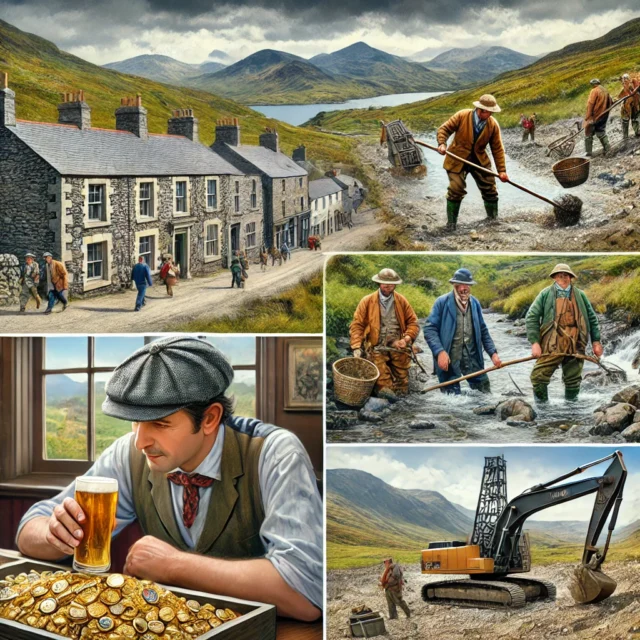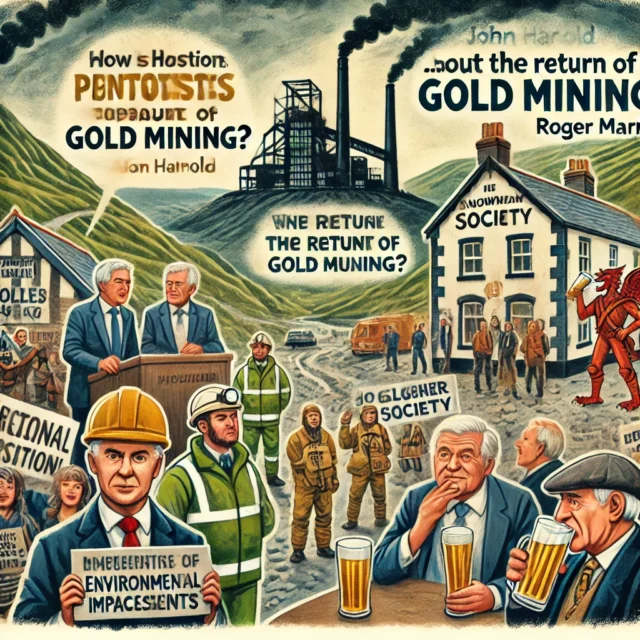Miners in Wales, Scotland, and Northern Ireland are hunting for sustainable gold mining reserves in the hills and mountains. Laura Cole wonders why the yellow metal quest has returned to the United Kingdom.
Pubs are a great spot to hear about the valley’s gold rush. In the former slate town of Dolgellau, north Wales, Roger Marr manages the Cross Keys Inn, and every now and then, an amateur gold panner shows up at his bar, raising a hand and tilting it to show off a ring between swallows of beer. ‘They’ll create one out of melted-down chunks they discover in rivers,’ Marr explains, ‘but finding enough of the stuff can take years.’
Dolgellau is the place to go if you’re after gold mining. The 3,000-person Snowdonian village sits in the crook of a gold belt that extends from the vast sands of Cardigan Bay, then bends northwards like an elbow for another eight miles before ending under the crumpled mountains. A gold industry grew up around two mines here, Gwynfynydd and Clogau, in the mid-nineteenth century, and peaked in the early twentieth century. Except for panning enthusiasts who swirl around in the shadows of stones and in slower water, where the metal is more likely to sit, the belt is generally unknown these days. ‘Every year, we have one Italian panner who comes to drink here,’ recalls Marr.
‘He travels up the mountain for a month and returns with enough money to pay for his return flight.’
Even with gold’s present high value, such stories are fascinating, especially during a slow winter. However, even the most skilled panner would agree it’s tough to make any money from the technique. This is partly due to panning’s shaky legality (you can’t sell what you uncover), but it’s also because it’s not particularly profitable. The gold in the streams is almost always in the form of nuggets. Pinhead-sized particles are typically expelled from the bigger lodes trapped in the rock. Most people feel that profiting from Welsh gold would necessitate the establishment of a commercial organisation.

The panners, however, are no longer on their own in their pursuit. Alba Mineral Resources, a mining corporation, bought the Gwynfynydd mine at the end of 2020, giving them access to the whole gold belt. In the context of a broader Covid-related slowdown in mining and exploration, the company’s goal to bring gold mines back to Snowdonia’s mountains may appear overly ambitious. It isn’t, however, the only commercial gold project underway in the United Kingdom. The golden innards of rocks beneath the Sperrin Hills in Northern Ireland and the Grampian Mountains in Scotland are also being sampled, drilled, and blasted. It’s no coincidence that all of the projects surfaced at the same time.
SEARCHING BEGINNING
Gold prospectors are optimistic. From the Grampians, Richard Gray, CEO of Scotgold, says, “This is the commencement of the Scottish gold mining industry.” George Frangeskides, executive chairman of Alba Mineral Resources in Wales, states, “This is the most significant discovery in decades.” In Northern Ireland, Patrick Anderson, CEO of Dalradian, claims that his project, located in West Tyrone’s Curraghinalt, has grown from a “tiny, early-stage deposit” to “one of the top gold mines on the planet.” Each corporation has its own hyperbolic claim.
The Dalradian project claims to be home to Europe’s largest gold deposit; Scotgold plans to open Scotland’s first gold mine; and Welsh land was once the most productive in the UK and is thought to contain tantalising ‘bonanza’ deposits, where gold can be found in potentially game-changing concentrations.
These projects’ locations add up to an approximate map of all known gold resources in the United Kingdom. Geologists in Scotland and Northern Ireland are studying the Dalradian supergroup, a band of rock that runs diagonally across the top of the UK, from Northern Ireland to the Grampians, like a sash.
The majority of this is sedimentary rock that formed 500–800 million years ago when the area was part of Laurentia’s shallow sea margin.
Map with gold
Around 500 million years ago, when what is now north Wales was a sea basin, the Dolgellau belt’s sedimentary bedrock originated on a distinct continent, Avalonia. These two continents eventually crunched together due to geological processes, pushing the Welsh basin and Scottish Highlands higher.

Veins of quartz, the milky threads seen in many rock types, are present in all of the formations. Superheated liquids pulse upwards from deeper in the Earth’s crust, frequently during mountain-building events, and permeate the host rocks’ pores, fractures, and fissures, forming these. The liquid condenses into quartz, together with any metals it has picked up along the way. Real gold can be found within these often illogically formed veins.
Each of the gold mining projects in the United Kingdom is looking for quartz veins, though at varying levels of development. Alba’s Welsh project is the most recent, and it exemplifies the early stages. The business has undertaken repeated exploratory efforts since acquiring a full stake in the Clogau mine in 2018. There are 20 miles of caverns beyond the entrance, which is an old-fashioned hole in the wall beneath a leafy overhang, some with quartz veins up to 15 metres thick. ‘We’re tracking them into Clogau Mountain and looking for possible mining extensions,’ Frangeskides says.
The hunt is also carried out from above. Alba has enlisted the help of geologists to scout the topside mountain pastures for untapped gold. Workers dig trenches to reach the bedrock and drill into it to look for hints of quartz veins beneath.
Dalradian in Northern Ireland, 186 miles to the northwest, has submitted a planning application to start blasting for a mine that will span two decades in 2022. In the meantime, Scotgold’s Cononish project is the most advanced. It had collected and crushed enough quartz to commence production by the end of 2020. A technician poured molten gold into a 999.9-purity piece of the metal at a processing plant in the rainy glen in December.
Within three years, if all three projects achieve their goals, gold will be mined from single mines in Snowdonia, the Grampians, and the Sperrin Mountains. Beyond that, each company has plans for expansion. Scotgold has agreed to explore 13 more places in the Highlands; Dalradian’s Anderson has stated that the company plans to expand to more than one mine in Northern Ireland; and Alba has located 10 ‘promising’ areas around the initial mine in Wales and is exploring for others. ‘It’s not out of the realm of possibility that we’ll discover one or more substantial virgin gold deposits as a result of our study,’ says Alba chairman Frangeskides. If the current trend continues, gold held in the United Kingdom will become accessible for purchase. So, what’s next?
SAFE HOUSES

The gold market experienced an unusual afternoon on July 24, 2020. There was new excitement at the second of two daily teleconferences among banks, which take place to set the price of gold in a way that reflects supply and demand. The price had been hovering above US$1,895 per ounce for several days, approaching the all-time high. The price shattered its previous high with the closing lines ‘there are no flags, we’re fixed’, a reference to the days when protests were signalled by raising a little Union Jack. It didn’t stop there. There was already talk that gold could surpass US$2,000 an ounce, following the 30% surge in demand it had experienced throughout the spring and summer.
‘In times of high uncertainty and high volatility, gold has once again shown to be the safe haven of choice,’ said Ruth Crowell, CEO of the London Bullion Market Association. Her remark encapsulated gold’s primary value to investors: as a safe haven during times of economic turmoil. In response to the financial impact from Covid-19 and declining confidence in currency strength, banks and private investors began buying gold in the hopes of securing some stability. This was a foregone conclusion. The value of gold is frequently inversely tied to the value of the US dollar, which leads to headlines like “Gold price surges as virus spreads” and “Gold increases with US-China tensions.”
‘The beauty of gold is that it likes bad news,’ wrote US novelist John Updike. The sardonic sheen of yellow metal is well-known in the industry.
Is the rising gold price to blame for new mining projects? Both yes and no. The price of gold affects the success of a new gold mine, but not immediately. Most mines take ten years to become productive, according to the World Gold Council, which is far too long to be able to capitalise on an unusual epidemic.
Nonetheless, the gold story in Scotland has followed price peaks and troughs.
A mining was attempted by a different business in the 1980s (when the all-time maximum gold value was reached owing to a recession, adjusted for inflation), but it failed when the price fell. Scotgold’s first breakthrough came ten years ago, following the financial crisis (exploring started in 2008). Similarly, Dalradian began looking into the Sperrins in 2009, when the price was high. ‘And it corresponds to when a lot of gold juniors popped up and found new projects all over the world,’ says Elizabeth Ferry, a Brandeis University economic anthropologist who studies gold mines and markets.
Although Alba’s Welsh project is newer, it is attempting to profit from the current gold price by prioritising historical mines and their existing infrastructure. ‘The first mine closed in the 1990s because gold was only about $300 an ounce at the time,’ adds Frangeskides. ‘When it hit US$2,000 an ounce, the economics of these projects became a lot more appealing to investors.’ All projects expect to strike high gold grades, but what they truly require is good timing, according to some.
RARE AND PRICELESS
Other mining renaissances in the UK, such as revived interest in tin, lithium, and tungsten, have mirrored the return of UK gold. Unlike these metals, however, gold does not appear to have gained industrial use. Only about 7% of gold is used in modern applications or technology, according to the World Gold Council. So, what’s the point of putting in the extra effort to mine more?
Anthropologist Elizabeth Ferry is fascinated by this topic because “frequently it gets down to the knotty philosophical question of “what is value”.” She argues that the vast majority of gold eventually ends up in central bank vaults, private holdings, or jewellery.
‘Really, its worth is in being kept, not in being used.’ This keepsake value is due in part to gold’s past life as a real currency; however, production has actually increased since the US unanchored gold from a fixed value of $35 per ounce in 1971. Since then, half of the world’s gold has been extracted.
‘We tend to think about gold rushes in the 1800s when we think of gold,’ adds Ferry. ‘However, the speed and size of modern gold mining in the last 50 years surpasses that of the previous age.’ In other words, large-scale gold mining and stockpiling is almost completely a contemporary occurrence.
Ferry attributes the increase in productivity to four primary sources. First, technological advancements have made it possible to access larger volumes of lower-grade deposits. Second, a thriving gold market has evolved as a result of glitzy new financial toys like gold exchange-traded funds, which have made the gold market more accessible to investors while also increasing its volatility. Third, she claims that gold investment is in high demand in Asia, notably in India and China. Finally, there’s the haven argument: in the last 50 years, three economic crises have justified the cost of extracting additional gold from the ground.
What role does UK gold play in this? Scottish gold is expected to be used in jewellery and will undoubtedly become a valuable asset due to its provenance. ‘It will certainly be a collectible item,’ says Alba’s Frangeskides of Welsh gold. If most gold is valued due to its rarity, Scottish, Welsh, and Irish gold will be much more desirable due to their rarity.
DETRACTORS FOR GOLD
Not everyone believes it’s a smart idea to mine this gold. ‘The gold does not benefit the local area,’ says Fidelma O’Kane, a former social worker turned mining opponent. It’s November, and O’Kane has just returned from the Department of Infrastructure’s Belfast office, where he spent 11 days reviewing Dalradian’s newest amendment.
Save Our Sperrins, led by O’Kane, is possibly the largest anti-gold-mining campaign in the UK. ‘I’m not typically the kind to go out and talk about this or that topic,’ she says, ‘but as the gold mine application progressed and I saw how harmful it could be, I thought it was our obligation to do something.’ Save Our Sperrins opposed Dalradian’s first planning proposal in 2017, citing environmental concerns. ‘Our primary worries are pollution threats to our air and water,’ says O’Kane.
Dalradian intends to build on a hill in County Tyrone, approximately 12 miles northeast of Omagh.
The terrain is a mix of tussocky grass and pockets of woods, with a portal to the bedrock and around a mile of tunnels already in place. Conservationists’ most vocal objections thus far have been to the tailings, or waste rock, that would be removed during the extraction. Gold must be crushed and separated from its quartz host when it is blasted from the mine’s rock face. The crushed tailings would be piled outside in a supervised tailings site, but there is concern that heavy metals like cadmium and mercury will seep into the county’s water system.
The campaigners are also concerned that tailings dust might be blown across a broad area of the country during windy periods, causing health problems.
‘The debate has also demonstrated how much rock must be lost in order to acquire access to relatively little amounts of gold,’ O’Kane says. To get to four tonnes of gold, Dalradian estimates that it will need to remove 511,000 tonnes of rock per year. 40,000 public comments on the proposal have been received by the Department of Infrastructure so far, with 37,000 of them opposing it. It is possible that a lack of public support has a cost.
‘The gold price may be high right now, but the profit margin on a gold mine is typically small,’ adds Ferry. ‘Social disagreement might cause productivity delays.’ The question is always raised: when do these costs outweigh the upside of the price?’
Although it’s difficult to forecast when and where gold mines will flourish around the world, some experts believe brownfield sites, or areas that have previously been mined, will perform best. ‘The best spot for a new mine is near to an old one,’ Frangeskides explains.
The phrase normally alludes to geology and the possibility for significant discoveries, but it can now also refer to local acceptability.

‘We can’t talk about mining and quarrying in Snowdonia without acknowledging the area’s long and significant history,’ says John Harold, the Snowdonia Society’s director. ‘They are really significant parts of the region’s story,’ he says, adding that Alba has yet to submit a planning application or conduct an environmental impact assessment. ‘There is a positive element of continuing a rich history, as long as that is balanced against the national park’s ecological and conservation duties,’ he says.
If gold can make us question the very idea of value, the process of opening a gold mine can do so even more. Back in the Cross Keys Inn, Roger Marr believes the return of gold mining could bring good things to Dolgellau. ‘Mining has been important here, why not bring it back to life?’ he asks.
One hundred and eighty-six miles away in Northern Ireland, near one of Europe’s richest gold finds, Fidelma
Gold articles:
Are Gold Britannia Coins a Good Investment?
How Much is a Gold Coin Worth?
UK Gold the Hunt for the Precious Metal Has Returned UK






